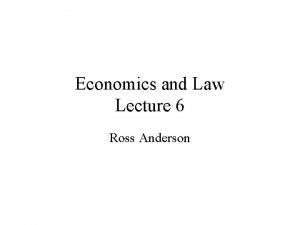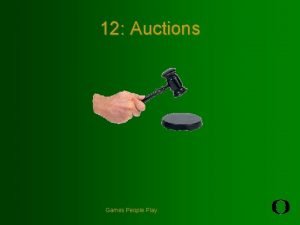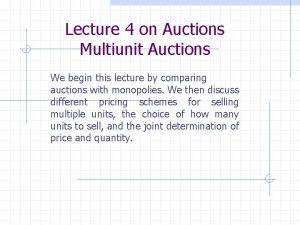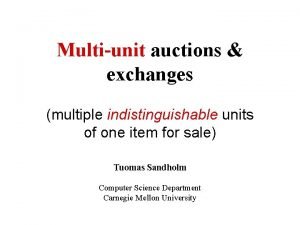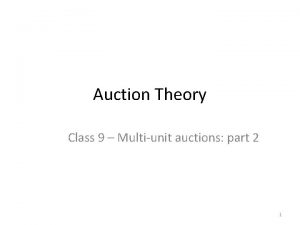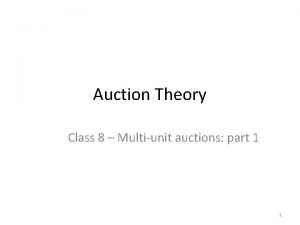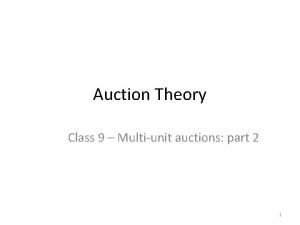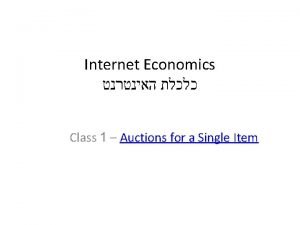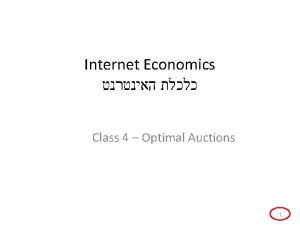Internet Economics Class 4 Multiunit auctions 1 Multiple


















- Slides: 18

Internet Economics כלכלת האינטרנט Class 4 – Multi-unit auctions. 1

Multiple items • Goal: design auctions that allow for multiple kinds of items – Items are non identical. • Examples: – Spectrum licenses covering different areas. – Baskets of financial assets. – Transportation of packages. – Advertising campaigns – Industrial equipment.

Desired properties • What would be desirable properties of such auctions? – Auction finds “market clearing” prices. – In equilibrium. . . – Auction rules are simple. – Robust to collusion, false-name bids, timing manipulations, etc. – Tractable: ends in reasonable time, bidders can compute their equilibrium strategies. • Bidders should not be expected to process or to report large amounts of data.

Challenges • Sealed-bid auctions? – Problematic. Bidder preferences may be complex. • Market-clearing prices may not exist – Especially when items are complements. • Bidders do not always know their preference… – Determining the preferences is often costly. • Do bidders know the equilibrium strategy in the complex auction?

Combinatorial preferences • Why shouldn’t we auction each item separately? • Auctioning each item alone ignores: – complements: v(TV) + v(VCR) < v(TV+VCR) – Substitutes: v(TV Toshiba) + v(TV Sony) > v(both TVs) • Bidding for packages (or bundles) may increase the efficiency of the auction.

Combinatorial preferences • We will next demonstrate the main ideas via a simple model: unit-demand bidders – Each bidder wants at most one item (but items are still nonidentical) • Non identical items: a, b, c, d, e, • Each bidder has a value for each item vi(a), vi(b), bi(c), . . • Each bidder wants one item only.

Example a b c Bidder 1 10 7 4 Bidder 2 0 8 5 Bidder 3 5 5 1 • What is the VCG outcome? 1. What is the efficient allocation? 2. VCG payment for Bidder 1? – Without Bidder 1, others gain 13. – With him, they gain 10. àp 1=3 Similarly, p 2=0, p 3=3. 7

Assumptions • Seller’s goal: maximize efficiency – By law for FCC spectrum auctions. • Seller does not know the values of the bidders – Here, even no distributional assumptions. • “Activity rule” – bidders must send bids constantly, otherwise be removed from the auction. – Prevents slow bidding and “sniping”.

Simultaneous Ascending Auction 1. Start with zero prices. 2. Each bidder reports her favorite item q Provisional winners are announced. 3. Price of over-demanded items is raised by $1. q Following bids by losing bidders. 4. Stop when there are no over-demanded items. – Provisional winners become winners. Claim: this auction terminates with: (1) Efficient allocation. (2) VCG prices ( ± $1 ) 9

Example a b c Bidder 1 10 7 4 Bidder 2 0 8 5 Bidder 3 5 5 1 • Let’s run the ascending-price auction now… • VCG payments: Bidder 1 pays 3 for a Bidder 1 pays 0 for c Bidder 3 pays 3 for b 10

Spectrum Auctions • The ascending auction we saw is called: Simultaneous Ascending Auction – Also known in the literature as tatonnement • Was introduced in 1994 for spectrum auctions. – Revolutionized the sale of spectrum. • Has been used since all over the world. • The basis of auctions for complex resource allocation problems. – Eg, transportation. 11

Why ascending price auction? • Simple and intuitive for bidders • “price discovery” – direct the attention of the bidders to the relevant items. – No need to determine the value of the other items/bundles. – For example: if they see an aggressive competition on one item, which become expensive, they may let it go. – Easier to assemble “packages” of items. • Decreases the amount of information broadcasted. – Again, bidders bid only on items that turn out to be relevant.

Equilibrium in the simultaneous ascending auction • Since the auction terminates with the VCG outcome, the auction is truthful. – Any deviation that leads to a different outcome will only hurt the bidders (same arguments as before). • This is more intuitive way to get to the VCG outcome – Analogous to 2 nd-price vs. Vickrey.

Market clearing prices • Conclusion: In a multi-unit auction with unit-demand bidders: This auction finds “market-clearing prices”: – every bidder receives his favorite item (given the prices) – all items are allocated (unless their price is 0). • The simultaneous ascending auction can be viewed as an intuitive way to reveal market-clearing prices. • The allocation that supports market clearing price is always efficient. 14

Why does it work? • For bidders that are interested in one item: the goods are substitutes. – If a bidder wants an Apple, and we increase the price of a Banana, the bidder will still demand an Apple. • This procedure actually reaches the efficient outcome for more general preferences. – As long the items are “substitutes”. • Example for complementarities: – Spectrum: covering contiguous areas. – Acquisition of two firms at the same business 15

Complementarities • This auction is problematic in the presence of complementarities. • Among the reasons: – Market clearing price do not exist. – Exposure problems. • What should one do with complementarities? – A problem. Not well understood. – Auction uses bundle prices. Or combinations of item and bundle prices. – More complex….

The exposure problem • bidders may have to make committing bids early in the auction, when they are uncertain about the eventual cost of the complete package. • Think about a new entrant to the spectrum market – Needs a certain minimal mass of spectrum to begin. – might end up with few very expensive spectrum, but not enough licenses. – Resell is not always possible • (opponents might have exhausted their budgets, legal problem etc. ) – Bidders fear of being “exposed” to losses, and this lead to conservative bidding and inefficiencies.

Next week • Online advertising • How search engines sell ads? • How users behave in search engines, and how it affects the ad market? 18
 Earl etienne dominica
Earl etienne dominica Type of auctions
Type of auctions Baystate auctions
Baystate auctions Ross sinclaire
Ross sinclaire Regretnet
Regretnet Ecommerce online auctions
Ecommerce online auctions Forward auction
Forward auction Anderson auctions
Anderson auctions Play auctions
Play auctions Economics and business economics maastricht
Economics and business economics maastricht Non mathematical economics
Non mathematical economics Aqa economics multiple choice questions
Aqa economics multiple choice questions Economics multiple choice questions aqa
Economics multiple choice questions aqa Multiple baseline across settings
Multiple baseline across settings Example of mimd
Example of mimd Internet or internet
Internet or internet How was today's class
How was today's class Package mypackage class first class body
Package mypackage class first class body Introduction to ooad
Introduction to ooad







